Monkey Shines (1988)
Directed by: George A Romero
Written by: George A. Romero, Michael Stewart
Starring: Jason Begde, Jason Beghe, John Pankow, Joyce Van Patten, Kate McNeil
USA
AVAILABLE ON DUAL FORMAT BLU-RAY AND DVD: 8th October, from EUREKA ENTERTAINMENT
RUNNING TIME: 113 mins
REVIEWED BY: Dr Lenera, Official HCF Critic
Athlete Allan Mann is struck by a truck. The surgery to save him renders him quadriplegic, and Allan becomes suicidal and despondent. Meanwhilehis scientist friend Geoffrey Fisher has been experimenting with the injection of human brain tissue into Capuchin monkeys. Learning of Allan’s situation, he gives one of his monkeys, named Ella, to Allan as a helper and gets helper monkey specialist Melanie Parker to train the animal. Things are fine at first, with Allan’s life being made much easier, and the two bonding deeply. But then their interaction takes a decidedly sinister turn as Ella seems to become a telepathic receptacle for Allan’s anger at his state and people who have wronged him….
Despite his reputation as a filmmmaker working outside the system, George Romero did every now and again dabble in major studio work, and the results were always far better than perhaps would be expected. Monkey Shines might be the best of these films – though if you’ve seen a certain Dario Argento film then you may find it hard not to chuckle when the chief Capuchin monkey starts wielding a razor. In fact I wondered if Romero saw the other movie and decided to expand upon one of its bewilderingly numerous story elements until I remembered it was adapted from a book. Of course they were making these kinds of ‘mad scientist experimenting on animals and/or humans with violent results’ stories even back in the 1930’s, but Romero’s film has a freshness and even an intelligence that renders it superior to many of its predecessors. It’s also very restrained, and has more of a ’70s than an ’80s pace to it which may make some first time viewers get restless during some of the first half. Indeed you could easily tell this story in 80 minutes, but for better or worse Romero often likes to take his time, and here this pays off because we really get to know our hero and feel his situation, meaning that we’re truly emotionally invested when things begin to to wrong. This doesn’t mean that there’s no terror though – you’ll be amazed how frightened you’ll become of a darn monkey, and Romero wrings every ounce of suspense from his main house setting and his small cast of characters. Yes, there are a few inconsistencies and things which just come off as silly [such as a monkey basically falling in love with a human – though if you think about it King Kong is even sillier in that respect] which maybe jar with the sober tone and handling, but as an example of Romero’s skill as a filmmaker, Monkey Shines, despite not featuring any zombies or indeed much blood, is a good one.
Based on a novel of the same title by Michael Stewart who was inspired by the Helping Hands organisation which trained monkeys to help disabled people, it was both written and directed by Romero for producer Charles [Robert’s older brother] Evans, then picked up by Orion for distribution. Romero adapted the novel quite closely but changed an important detail concerning Allan’s condition. The shooting script would have made for a three hour film and he and executive producer Peter Grunwald holed up in a shack for several days arguing as they cut it down.Two monkeys were used, the first one being a replacement for another, but because like most helper monkeys he’d had his teeth pulled out, he wasn’t much good for close-ups so a third one had to be located and ended up being used far more. Shot, as with many Romero pictures, in his hometown of Pittsburgh, the first edit was around two and a half hours long. Orion understandably wanted cuts, including the removal of a brain surgery scene and several abusive scenes involving Ella even though no monkeys were harmed in the making of the movie. Then, after a preview in which they misunderstood why viewers didn’t like the ending, they first got Romero to provide a happier conclusion and to cut his original ending involving Dean Harold Burbage, animal rights protesters, and more monkeys, then asked to him film a Carrie-like shock moment for the ending. Small wonder that Romero retreated back into independent filmmaking for some time. Monkey Shines was fairly well received by critics for a horror movie, but Orion didn’t distribute it very widely and the public stayed away, despite some picketing of cinemas by wheelchair uses because the awful poster included a reference to a wheelchair as a “prison”.
Our ‘hero’ seems to have a great life as he wakes up beside his pretty girlfriend Linda Aikman and goes jogging with bricks in his rucksack. David Shire’s music is almost too soaring, too happy, but that’s of course deliberate so that his run-in with a truck has more impact. A smashed brick is all that Romero needs to convey the effect, warning any gore hounds watching that this film will not splash loads of the red stuff. A great deal of time is then spent detailing Allan’s subsequent physical and mental situation. Yes, much of this could have been cut down to speed up the pace. Take for example Linda ditching him and moving on to another character. This is shown quite gradually, more gradually than many filmmakers would want – but Romero wants us to really sympathise with this guy whose life was changed in a second and who’s now reduced to being in a wheelchair, so he takes his time – though for a few moments [this was the first time I’d seen this film in at least 20 years] I was most interested in seeing a very young Stanley Tucci with a decent amount of hair as Dr. John Wiseman, the person who saved his life. Still, the sensitive yet unsentimental portrayal here of extreme disability is very praiseworthy. Barely able to do anything except turn pages with a straw, unable to have sex, and his mental state hardly helped by his in-your-face mother Dorothy and none-too-sympathetic nurse Maryanne Hodges, it’s little surprise that he tries to kill himself. Meanwhile there’s another sub-plot going on, that off Geoffrey Fisher doing his experiments, with the somewhat unscrupulous Dean Harold Burbage, who thinks nothing of what is basically torturing a rat, always on his back for results. Geoffrey isn’t the most sensible guy, continually injecting himself with something to stay awake, but he’s sympathetic nonetheless. This portion of the story seems to have had more cut from it as a few things are not entirely clear, while Allan’s tale flows fine and has no obvious edits.
Things improve for Allan when little Ella becomes his aide and Allan becomes attached to both her and Melanie Parker who’s definitely more his type, though Geoffrey has to keep turning up to give Ella her injections on the sly. Ella’s great intelligence is initially a godsend, and one can understand when she tries to bash Geoffrey’s hand in with a cheese grater during one attempt at injecting the human brain tissue. One can even understand when Maryanne’s annoying and even dangerous pet bird is killed by Ella who by the way seems able to get in and out of her cage at will. But surely Allan shouldn’t dream that he’s Ella running and leaping around outside, and why does he sometimes seem to become a colder, even nastier, character? Is Ella’s mind influencing his, and when a murder occurs, is Ella beginning to act out things that he imagines, a variation on taking thing really literally? And why is he able to move his hand at one point? The Jekyll and Hyde-inspired aspect, with Allan reverting back to what he says is animal instinct, is a little under developed, though of course Romero did it again later on with The Dark Half and Bruiser. And Jason Beghe, an actor who’s done mainly TV work and whom I don’t think I’ve seen in anything else, pulls his part off very well, able to change his voice, manner and facial expression in quite a chilling way.
While some other directors may have chosen to render the big battle – which is as much of minds as bodies – between man and monkey with stylised visuals, Romero mostly keeps things internal. Even the kills are tame – an electrocution in a bath is less graphic then the one in Goldfinger – but it doesn’t feel that Romero has restricted himself even if he’s not interested in delivering shocks, though there’s one brilliant ‘jump’ when Ella suddenly appears beside a potential victim. Unfortunately that added final scare, seemingly inspired less by Carrie than another classic 70’s horror scene, just seems out of place and features a really poor special effect to boot. Most of the monkey scenes do convince though – only in one attack scene does Romero have to resort to the usual quick cuts to disguise the fakery, and it’s obvious that the monkey really is doing most of the things she appears to be doing, with only the occasional Tom Savini-made model hand or body turning up and being barely noticeable. Boo, the main monkey playing Ella, is somehow able to be adorable, provide pathos, and scare whenever required. I saw worse human actors in a film I saw the other day. There’s little of the Romero humour here [okay Ella wees on Allan] or the social commentary [though it’s interesting how Ella is the first to treat Allan as an equal], the man just concentrating on telling a story as best he can, a story that of course is another warning against tampering with nature. The romantic aspect is especially nicely handled, so that we believe the growing attraction between Allan and Melanie. When they have sex, what’s interesting is how Allan, even though he probably can’t feel a thing, is concentrating purely on giving the other person great pleasure even though he can’t experience it, and how Ella seems to be helping [I know this sounds daft but watch the film….].
John Pankow as excellent as Geoffrey, who truly has his friend’s best interests at heart even if he rarely seems to actually do the right thing. Only Romero regular wife Christine Forrest doesn’t seem quite right amongst the cast, going rather over the top, while Shire’s omnipresent score is tremendous, managing to be lyrical, frightening and even getting away with comical monkey music! Henry Mancini was Romero’s first choice for composer but I doubt he would have done as good as job as Shire. There’s some vagueness hear and there, and one prominent character disappears half way through – though if they’d kept the original ending that wouldn’t be the case. Nonetheless, despite its hoary old premise, Monkey Shines is thoughtful, involving and sometimes bed-wettingly tense. After Knightriders, I feel it may be Romero’s most underrated picture.
Rating: 









Monkey Shines on UK Blu-ray from Eureka Entertainment looks a little soft at times, but overall is very film-like and the slight muting of the colours looks and feels accurate. Both audio tracks sound almost the same on a standard set-up, the 2.0 one just slightly louder. Balance seems just right, though I doubt that the music score would be given as much prominence if the film were made today.
Eureka have ported all the special features from Scream Factory’s 2014 Region ‘A’ release and added one of their own. Sadly, it’s not too great, though at least it comes first so you can get it out of the way. The new audio commentary from film journalist Travis Crawford [who’s done three previous Romero commentaries which I haven’t heard] spends about two thirds of its time detailing the credits of cast and crew, even going through the careers of some other horror directors to compare them to Romero. There’s the odd interesting tidbit, like Romero wanting to use Ella Fitzgerald songs but her agent claiming that she wouldn’t want to be involved with such a movie so they had to use Peggy Lee instead, and Travis says that he didn’t want to replicate things from Romero’s commentary, but surely he could have done better than this? Never mind, Romero’s track is terrific as usual. Moderator Stuart Friedback Andrews asks all the right questions but Romero often mentions things on his own, such as when it’s a fake monkey. There’s a hell of a lot of stories here, especially concerning the monkeys. I particularly loved the one about Boo, no doubt meaning well, suddenly taking some poo from his bottom and giving it to Begbe. Romero is clearly pleased with the film despite his dislike of Orion’s meddling. He continually comes across as a really lovely guy who’s also full of interesting things to say, but Andrews is fun to spend time with too with a nice sense of humour. Great stuff.
An Experiment in Fear – The Making of Monkey Shines runs 49 minutes and sees Romero, the three lead performers and members of the crew discuss the conception, shooting and release of the film, and mainly with considerable warmth in their recollections. Much of the information is on the Romero commentary, but there’s some extra amusing stuff about the monkeys, a bit of behind the scenes footage including some goofing around by the special effects crew with a puppet monkey on a string, and discussion of the cut brain surgery scene including shots from it. Sadly the scene is not in the Deleted Scenes section which only runs four minutes and just has a few short scenes and scene portions, mainly of Allan and his mother, who doesn’t believe him when his hand moves again. There’s undoubtedly more cut stuff, but maybe Scream Factory couldn’t find it. The music score is almost deafening in these and you can’t always hear what people are saying. Then we get the full Alternate Ending which – I don’t know – Romero and others clearly prefer it but having finally seen it myself, I don’t think it entirely suits the film in my opinion even if it does return to a subplot that disappears in the final cut.
The EPK Featurette runs five minutes and has some nice behind the scenes stuff as Romero talks up the film. Then we have five minutes of the full versions of the interviews partly shown in the EPK, plus thirteen minutes of behind the scenes stuff. We saw some of this is in An Experiment In Fear, but it’s fun to see more of McNeil befriending one of the monkeys, the puppet monkey, and the effects crew trying out the animatronic monkey to see if it’ll do certain things. It really does look pretty good.
A fine George Romero film on an extras-packed disc? The Doc Thoroughly Recommends – of course!
DETAILS
*Limited edition O Card slipcase (First print run only
*1080p presentation of the film on Blu-ray
*DTS-HD MA 5.1 and 2.0 audio options
*Optional English SDH subtitles
*New and exclusive feature length audio commentary by Travis Crawford
*Audio Commentary with director George A. Romero
*An Experiment in Fear – The Making of “Monkey Shines”
*Deleted Scenes
*Alternate Ending
*Behind-the-scenes footage, original EPK featurette, vintage interviews and news reports
*Trailers and TV spots
*PLUS: A limited edition collector’s booklet featuring a new essay by Craig Ian Mann, highlight’s from the film’s production notes, and rare archival material (First print run only)

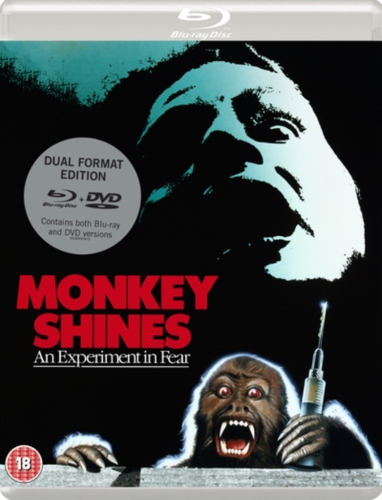
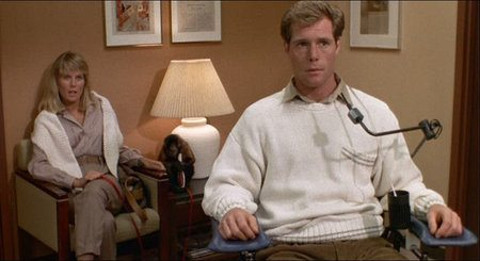
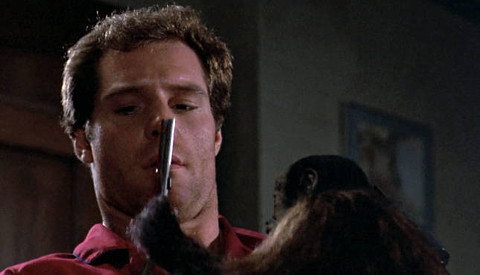

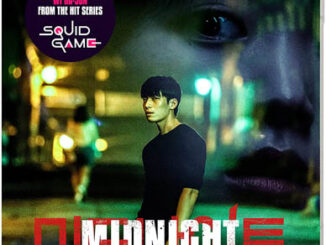
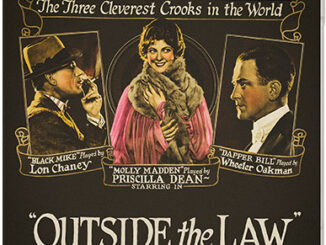

Be the first to comment